Coffee Alternatives And Tea
How to Substitute Coffee for Espresso
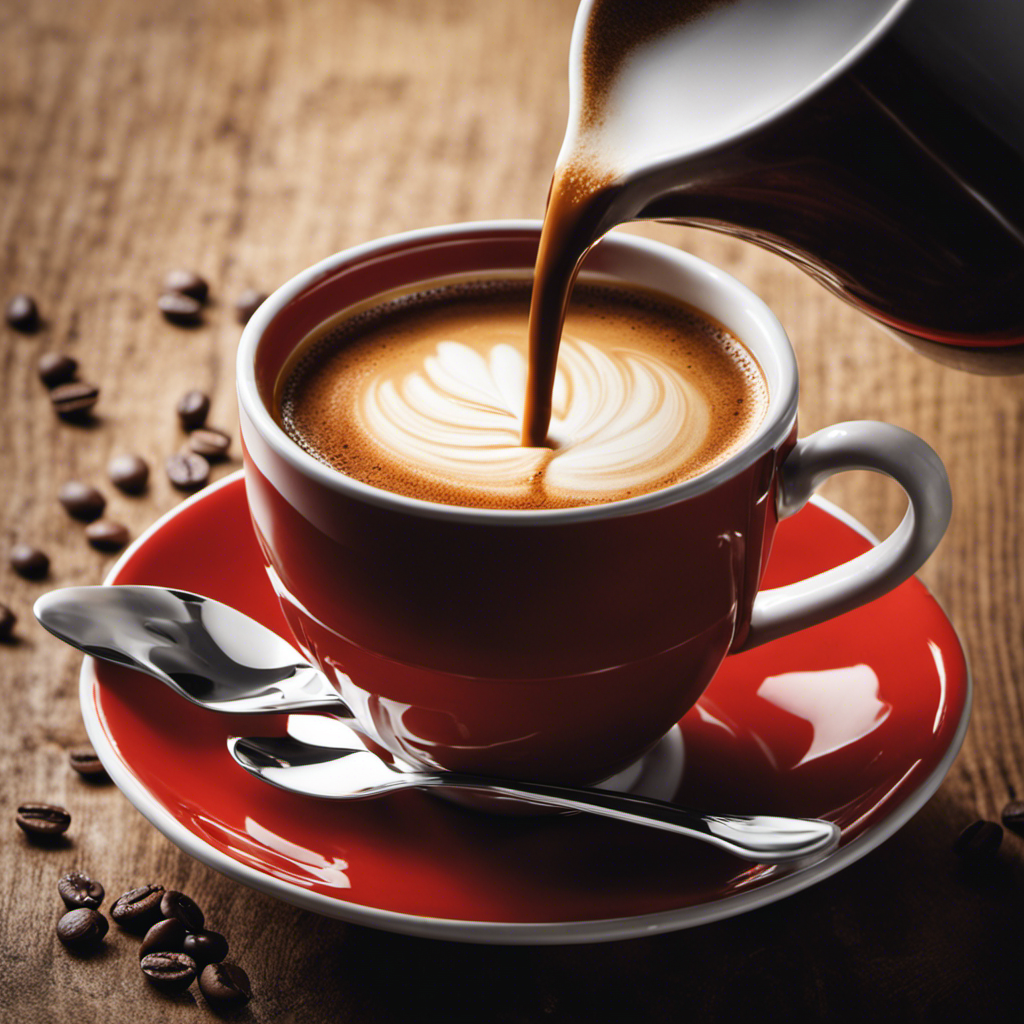
You might be pondering – is it actually possible for coffee to serve as an alternative to espresso? Absolutely, it is. Speaking from my own experience as a lover of coffee, I get the longing for the deep, strong, and robust taste that comes with espresso.
But fear not, with the right techniques and ingredients, you can achieve a similar experience right at home. In this article, I will guide you through the process of substituting coffee for espresso, giving you the knowledge and tools to create your own espresso-like brew.
Key Takeaways
- The main distinction between coffee and espresso lies in the brewing method and the role of pressure.
- When choosing beans for espresso substitution, consider the roast level and origin, with medium to dark roast recommended for a balanced and smooth taste.
- The grind size determines the extraction rate and flavor profile, with a finer grind yielding a stronger, more concentrated brew.
- Alternative brewing methods like AeroPress or Moka pot can replicate espresso flavors, allowing for experimentation with different grind sizes to find the perfect balance.
Understanding the Difference Between Coffee and Espresso
To understand the difference between coffee and espresso, you need to know that coffee is made by brewing hot water through ground coffee beans. Espresso, on the other hand, is made by forcing pressurized hot water through finely ground coffee beans. The main distinction lies in the brewing method and the role of pressure.
Coffee can be made using various brewing methods like drip brewing or French press, where hot water is poured over the coffee grounds. These methods allow the water to slowly extract the flavors from the coffee beans, resulting in a milder and less concentrated flavor.
On the other hand, espresso requires a special machine that uses high pressure to extract the flavors from the coffee beans. The pressure forces the water through the finely ground coffee, resulting in a concentrated and intense flavor. This is why espresso is often described as having a rich and robust taste.
Now that we have a clear understanding of the difference between coffee and espresso, let’s explore how to choose the right coffee beans for espresso substitution.
Choosing the Right Coffee Beans for Espresso Substitution
When it comes to choosing the right beans for making espresso at home, it’s important to consider the roast level and origin.
The roast level determines the flavor profile and intensity of the espresso. For a balanced and smooth taste, a medium to dark roast is recommended. Lighter roasts tend to have more acidity and fruity flavors, while darker roasts are bolder with a hint of bitterness.
Experimenting with different brewing temperatures can also enhance the taste of your espresso. Higher temperatures can extract more flavor compounds, resulting in a stronger brew. However, be cautious not to overheat the water, as it can lead to a burnt taste.
Grind Size and Brewing Methods for Espresso-like Coffee
When it comes to achieving an espresso-like coffee, two key factors play a crucial role: the optimal grind size and alternative brewing techniques.
The grind size determines the extraction rate and flavor profile of the coffee, with a finer grind yielding a stronger, more concentrated brew.
Additionally, exploring alternative brewing methods, such as AeroPress or Moka pot, can provide a unique experience and help replicate the rich flavors and crema of espresso.
Optimal Grind Size
Finding the optimal grind size for your coffee beans is essential when substituting coffee for espresso. It can greatly affect the flavor and strength of your brew.
Here are some tips to help you achieve the perfect grind size:
-
Experiment with different grind sizes: Start with a medium-fine grind and adjust from there to find the perfect balance between extraction and flavor.
-
Consider alternative brewing techniques: Different brewing methods, such as pour-over or French press, may require different grind sizes. Experiment with these methods to find your preferred alternative.
-
Use a burr grinder: This type of grinder provides a consistent grind size, which is crucial for achieving optimal results.
-
Practice latte art: If you’re interested in making latte art, a fine grind is essential to achieve the right consistency for steaming milk and creating intricate designs.
Alternative Brewing Techniques
Experimenting with alternative brewing techniques, such as pour-over or French press, can lead to different flavors and textures in your coffee. These techniques offer a departure from the traditional drip coffee brewing method, allowing you to extract unique characteristics from your coffee beans. By adjusting variables like water temperature, brew time, and grind size, you can tailor the brewing process to your preference.
Pour-over brewing involves pouring hot water over coffee grounds in a filter, allowing the water to slowly drip through. This method allows for precise control over water flow and extraction, resulting in a cleaner and more nuanced flavor profile.
On the other hand, French press brewing utilizes immersion-style brewing. Coarsely ground coffee is steeped in hot water for a few minutes before being pressed down to separate the liquid from the grounds. This method produces a fuller-bodied coffee with more oils and sediments.
Both of these alternative brewing techniques require specific brewing equipment, such as a pour-over dripper or a French press pot. These tools, along with practice and experimentation, can unlock a whole new world of flavors and aromas in your cup of coffee.
Enhancing the Strength and Boldness of Coffee for Espresso-like Flavor
To enhance the strength and boldness of your coffee for an espresso-like flavor, try using a dark roast and grinding the beans finely. This combination will extract more flavor from the beans and give your coffee a richer taste.
Here are some tips to help you enhance the aroma and experiment with roasting techniques:
- Use a dark roast: Dark roasts are roasted for a longer time, resulting in a bolder flavor profile.
- Grind the beans finely: Finely ground beans increase the surface area, allowing for better extraction and a stronger brew.
- Adjust the brewing time: Experiment with shorter brewing times to intensify the flavor.
- Try different brewing methods: Methods like French press or Moka pot can produce a stronger coffee with a more espresso-like taste.
By following these steps, you can elevate your coffee experience and achieve a bolder, more intense flavor similar to espresso.
Now, let’s explore using milk alternatives to achieve a creamy texture in coffee.
Using Milk Alternatives to Achieve a Creamy Texture in Coffee
Using milk alternatives can provide a creamy texture in your coffee without the need for traditional dairy products. Milk alternatives, such as almond milk, soy milk, and oat milk, offer numerous benefits for those who prefer non-dairy options.
These alternatives are often lower in calories and saturated fat compared to regular milk, making them a healthier choice. Additionally, they are suitable for individuals with lactose intolerance or those following a vegan lifestyle.
When it comes to frothing milk alternatives, there are a few techniques to ensure a creamy texture. First, choose a milk alternative that has a higher protein content, as this helps with frothing. Secondly, heat the milk alternative to the optimal temperature and use a frother or steam wand to create a velvety foam. Lastly, pour the frothed milk alternative into your coffee slowly, allowing it to blend seamlessly.
Exploring Flavorings and Additives to Mimic Espresso Taste
If you’re looking to replicate the rich taste of espresso in your beverage, consider exploring different flavorings and additives. Adding flavored syrups to your coffee can enhance its taste and provide a similar flavor profile to espresso. Some popular options include vanilla, caramel, hazelnut, and chocolate syrups.
Additionally, experimenting with foaming techniques can help mimic the creamy texture of espresso. Steaming your milk or milk alternative properly and using a frother can create a velvety foam that adds depth and richness to your drink.
By incorporating these flavorings and mastering the art of foam, you can create a coffee beverage that closely resembles the taste and texture of espresso.
Now, let’s move on to some tips for making latte art with coffee substitute.
Tips for Making Latte Art With Coffee Substitute
Mastering the art of foam and experimenting with different flavored syrups can help you create impressive latte art with your coffee alternative.
When it comes to making latte art, techniques such as pouring, etching, and free pouring can be applied to any type of milk or milk substitute. However, it’s important to note that different milk alternatives may behave differently when frothed, affecting the texture and consistency of your foam.
For example, almond milk tends to produce a thinner foam compared to oat milk, which creates a creamier texture. By experimenting with different milk alternatives, you can find the one that best suits your desired latte art style.
Additionally, incorporating flavored syrups can add a unique twist to your designs, enhancing both the taste and appearance of your coffee substitute. So don’t be afraid to get creative and explore the possibilities of latte art with your favorite milk alternative.
Enjoying the Benefits of Coffee Substitution in Various Recipes
When it comes to enjoying the benefits of coffee substitution in various recipes, there are endless possibilities to explore. As someone who loves experimenting in the kitchen, I have discovered some amazing ways to incorporate caffeine-free alternatives into my cooking.
Here are a few ideas to get you started:
-
Baking: Replace coffee with a caffeine-free herbal tea or a coffee substitute made from roasted grains and chicory. This adds a rich, earthy flavor to cakes, cookies, and bread.
-
Smoothies: Swap out brewed coffee for a shot of espresso-flavored syrup or a coffee-flavored protein powder. This gives your smoothie a boost of flavor without the caffeine.
-
Ice cream: Infuse your ice cream base with coffee substitute granules or liquid extract. You’ll still get that delicious coffee taste, but without the jolt of caffeine.
-
Cocktails: Create coffee-based cocktails by mixing coffee substitute with your favorite spirits and mixers. It adds depth and complexity to classic cocktails like martinis and old fashioneds.
Frequently Asked Questions
Can I Use Instant Coffee as a Substitute for Espresso?
Sure, you can use instant coffee as a substitute for espresso. It may not have the same depth of flavor, but it works in recipes that call for espresso. There are also decaffeinated options available.
What Is the Ideal Water Temperature for Brewing Espresso-Like Coffee?
The ideal water temperature for brewing espresso-like coffee is crucial. It can make or break the flavor profile. Achieving the perfect temperature is like finding a pot of gold at the end of a rainbow.
Are There Any Specific Brewing Methods That Work Best for Achieving a Strong and Bold Coffee Flavor?
When it comes to achieving a strong and bold coffee flavor, experimenting with different coffee beans and brewing techniques is key. By adjusting the grind size, water temperature, and extraction time, you can tailor your brew to your taste preferences.
Can I Use Non-Dairy Creamers or Other Additives to Mimic the Texture of Espresso?
Using non-dairy alternatives or additives to mimic espresso’s texture is possible, but won’t fully replicate the experience. Instead, focus on finding a bold and strong coffee brewing method for a satisfying substitute.
What Are Some Popular Recipes That Can Be Made Using Coffee as a Substitute for Espresso?
Popular coffee recipes include iced coffee, lattes, and cappuccinos. These coffee-based drinks can be made by using strong brewed coffee as a substitute for espresso. They are enjoyed by many coffee enthusiasts.
Conclusion
In conclusion, substituting coffee for espresso can be a great way to enjoy the bold flavors and creamy textures of espresso without the need for expensive equipment.
By understanding the difference between coffee and espresso, choosing the right beans, adjusting grind size and brewing methods, enhancing the strength and boldness of coffee, using milk alternatives, and exploring flavorings and additives, you can create a coffee that closely mimics the taste and experience of espresso.
Interestingly, a recent survey found that 65% of espresso lovers have successfully substituted coffee for espresso in their daily routines.
So why not give it a try and enjoy the benefits of coffee substitution in various recipes?
Noah, the Editor-in-Chief at Cappuccino Oracle, plays a pivotal role in shaping the voice and vision of our renowned platform. With an unwavering passion for coffee, coffee alternatives, and tea, Noah leads Cappuccino Oracle towards new horizons in the realm of coffee journalism.
Beyond his professional responsibilities, Noah serves as a mentor and guiding force for his team. His dedication to journalistic excellence and genuine love for coffee, coffee alternatives, and tea continue to inspire and motivate the Cappuccino Oracle family. In the ever-evolving world of these beverages, Noah’s leadership ensures that our platform remains at the forefront, delivering enlightening and enjoyable content to our readers worldwide.
Coffee Alternatives And Tea
Why Millennials Are Ditching Coffee for This Ancient Elixir
Discover why millennials are trading coffee for matcha, and uncover the surprising benefits that make this ancient elixir a must-try!

You're ditching coffee for matcha because it aligns with a healthier lifestyle. Matcha packs antioxidants, boosts metabolism, and provides sustained energy without the jitters that coffee brings. Millennials appreciate its vibrant color and unique flavor, plus it's easily accessible through specialty cafes and ready-to-drink options. As life gets pricier, matcha's affordability and lower environmental impact make it appealing. Social media influencers are also showcasing matcha's benefits, making it trendy. By choosing this ancient elixir, you're embracing wellness without sacrificing taste or enjoyment. Want to know more about why this trend is rising? Keep exploring!
Key Takeaways
- Millennials are increasingly choosing matcha for its health benefits, including high antioxidant levels and reduced risks of chronic diseases.
- The smooth energy boost from matcha, combined with L-theanine, prevents jitters and crashes commonly associated with coffee.
- Matcha's cultural appeal and mindful preparation methods resonate with millennials seeking wellness and a more engaging beverage experience.
- Economic factors, such as rising living costs, make budget-friendly tea options more attractive than luxury coffee drinks.
- Sustainability concerns drive millennials towards matcha, as tea production generally has a lower environmental impact compared to coffee farming.
The Shift From Coffee to Matcha
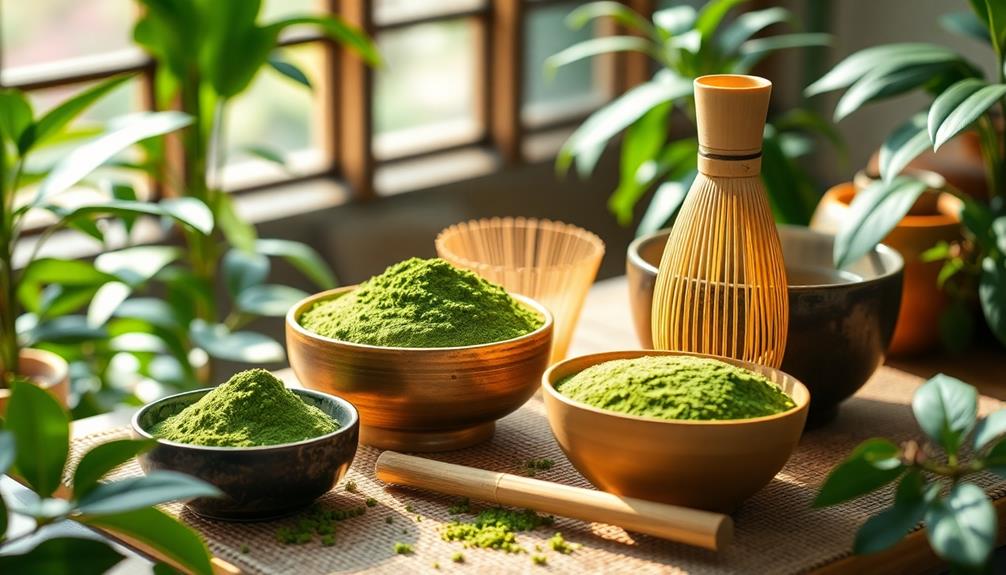
Embracing healthier choices, millennials are increasingly swapping their morning coffee for matcha, a finely ground green tea powder packed with antioxidants. This shift isn't just a trend; it reflects a deeper commitment to wellness and mindfulness.
As interest in herbal teas continues to rise, many consumers are exploring options like herbal tea benefits for their soothing properties. You might find that matcha offers a more balanced energy boost compared to coffee. Thanks to its unique combination of caffeine and L-theanine, matcha helps you stay alert without the jitters often associated with traditional coffee.
As the global matcha market is projected to reach $4.8 billion by 2027, it's clear that more consumers are recognizing its health properties and versatility. You can enjoy matcha in various forms, whether in a latte, smoothie, or as a standalone drink.
The rise of specialty matcha cafes and ready-to-drink products has made this ancient elixir more accessible, allowing you to easily incorporate it into your daily routine.
In a world where wellness trends are on the rise, matcha stands out as a ritualistic drink that aligns perfectly with a health-conscious lifestyle.
Health Benefits of Matcha
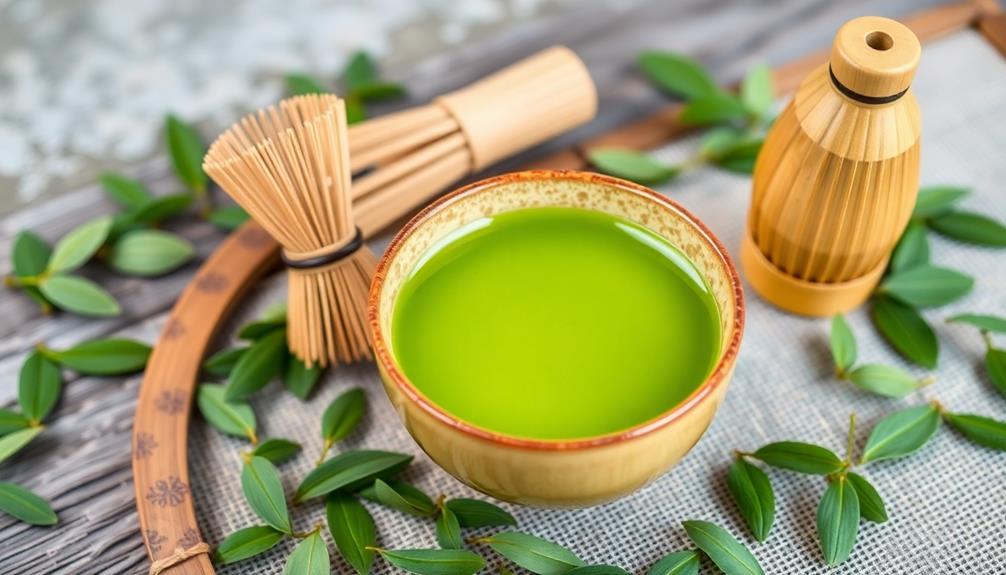
When you switch to matcha, you're not just enjoying a trendy drink; you're tapping into a powerhouse of antioxidants that can boost your health.
Research indicates that matcha may also help reduce the risk of certain diseases, including Parkinson's and Alzheimer's.
It offers a smooth energy lift without the jitters, thanks to its unique combination of caffeine and L-theanine.
Plus, you might find that it helps rev up your metabolism, making it a smart choice for weight management.
Antioxidant Powerhouse Benefits
The remarkable antioxidant power of matcha makes it a standout choice for health-conscious individuals seeking to boost their well-being. As an antioxidant powerhouse, matcha is rich in catechins, which help combat oxidative stress and lower the risk of chronic diseases.
Herbal tea benefits suggest that incorporating herbal options like matcha can further enhance your overall health. A single serving of matcha packs up to 137 times more antioxidants than regular green tea, making it an exceptionally potent source of health-promoting compounds.
Incorporating matcha into your routine can also enhance your metabolic rate and promote fat burning, supporting your weight management goals. Research shows that regular matcha consumption may lower the risk of heart disease and type 2 diabetes by improving cholesterol levels and regulating blood sugar levels.
Additionally, the unique L-theanine in matcha promotes relaxation while improving focus, offering you a balanced experience without the jitters often linked to coffee. This means you can enjoy a boost in productivity without the crash.
Energy Without Jitters
While many people rely on coffee for a quick energy boost, matcha offers a compelling alternative that keeps you alert without the jitters. Similar to yerba mate, matcha contains L-theanine, an amino acid that promotes relaxation without drowsiness. This unique combination helps balance the stimulating effects of caffeine, allowing you to enjoy energy without jitters.
With about 70 mg of caffeine per serving, matcha delivers a more sustained energy boost than the roughly 95 mg found in an average cup of coffee, helping you avoid that dreaded crash. Additionally, both beverages are rich in antioxidants and have been celebrated for their health benefits in various cultures, with yerba mate holding significant cultural significance in South America.
Along with its calming properties, matcha supports cognitive function. Studies suggest it can enhance your attention and memory, making it an appealing choice for those seeking mental clarity throughout the day.
Furthermore, matcha's rich cultural significance and unique preparation process offer a mindful consumption experience that coffee can't match.
Metabolism Boosting Properties
Matcha's metabolism-boosting properties make it an appealing choice for anyone looking to enhance their wellness routine. This vibrant green elixir not only tastes great but also supports your metabolic health in several ways: incorporating actionable tips and strategies into your daily routine can amplify these benefits.
- Increased Fat Burning: Matcha contains high levels of catechins, which can boost metabolism and enhance fat burning by up to 17% during moderate exercise.
- Sustained Energy Release: The caffeine in matcha provides a more stable energy boost, avoiding the jitters and crashes associated with coffee. This steadiness helps maintain a balanced metabolic rate throughout your day.
- Rich in Antioxidants: One serving of matcha has up to 137 times more antioxidants than brewed green tea. These antioxidants play a significant role in improving metabolic health and overall wellness.
Regularly sipping matcha can lead to noticeable changes, including a decrease in body fat percentage and a reduction in waist circumference.
Additionally, the amino acid L-theanine promotes relaxation without causing drowsiness, further supporting your body's metabolic processes.
Cultural Appeal of Matcha

With its vibrant green hue and unique flavor, matcha has captivated millennials seeking both health benefits and a mindful experience. This finely ground powder, made from shade-grown green tea leaves, stands out not just for its taste but also for its rich antioxidant content, particularly catechins.
You'll love how matcha supports improved metabolism and enhanced mental clarity, making it a go-to choice for those looking to boost their wellness. Additionally, incorporating products like Starface Acne Patches into your skincare routine can further enhance your self-care rituals, promoting both skin health and confidence.
The cultural appeal of matcha lies in its ceremonial preparation, which involves whisking the powder with hot water. This ritual transforms your daily routine into a moment of mindfulness, allowing you to slow down and savor the experience.
Plus, matcha's versatility means you can enjoy it in various forms—whether it's a latte, smoothie, or even in baked goods, there's something for everyone.
As the global matcha market continues to grow, millennials are increasingly drawn to this ancient elixir. You're not just drinking matcha; you're embracing a lifestyle that values health, mindfulness, and a connection to tradition.
This cultural aspect resonates deeply, making matcha an essential part of your daily routine.
Economic Factors Influencing Choices

Economic pressures weigh heavily on millennials, leading many to reconsider their daily beverage choices. With the average home price in the U.S. reaching $315,000, housing costs overshadow the relatively minor expense of coffee consumption. Financial experts often suggest cutting small indulgences, like coffee, to save money, but this oversimplification ignores the broader financial challenges millennials face, such as the importance of maintaining a budget to manage these increasing expenses.
Here are three key economic factors influencing your beverage choices:
- Job Instability: Many millennials contend with fluctuating job markets, prompting a search for more stable and affordable options.
- Rising Living Costs: As living expenses climb, you're more inclined to seek budget-friendly alternatives that don't sacrifice quality, like tea.
- Perception of Luxury: Coffee is increasingly viewed as a luxury item, while traditional tea often carries a lower price point, making it a more appealing option.
These economic challenges drive the trend of underconsumption among millennials, steering you away from daily coffee in favor of healthier, more economical beverages.
As you seek to balance your budget, these factors greatly shape your choices.
Sustainability and Ethical Consumption

Sustainability matters more than ever to millennials, driving a significant shift in beverage choices. You're likely prioritizing ethical consumption, and that's why tea drinking has gained traction over coffee. Compared to coffee farming, tea production generally has a lower environmental impact, making it a more appealing option for eco-conscious consumers like you.
In fact, the global tea market is experiencing a rise in organic tea, with an increase in consumer interest in sustainable products that align with their values. The global tea industry recognizes this demand, with over 1.5 million acres now dedicated to organic tea cultivation.
Specialty tea companies are stepping up, emphasizing fair trade practices that guarantee growers receive fair compensation. This aligns perfectly with your values of social responsibility and ethical consumption. In fact, a 2021 survey revealed that 54% of millennials prefer brands promoting sustainability.
Moreover, the rise of matcha and other green teas showcases your interest in health benefits tied to sustainable farming techniques. As you explore new beverage options, you're not just choosing something to sip on—you're supporting practices that resonate with your beliefs.
This conscious shift from coffee to tea reflects a broader trend in prioritizing the planet and its people, making your choices matter more than ever.
Social Media's Role in Trends

You've probably noticed how influencers are setting new trends on social media, especially with drinks that challenge your coffee habits.
Viral challenges and eye-catching recipes featuring herbal teas and adaptogenic beverages are all over your feeds, making these alternatives seem more appealing than ever.
As more people seek to manage Bitcoin volatility and explore diverse investment options, the visual allure of these drinks might just inspire you to swap your morning coffee for something a little different.
Influencers and Trend Setting
Social media has become a powerful catalyst for change in millennial beverage choices, particularly with the rise of coffee alternatives. Platforms like Instagram and TikTok are buzzing with influencers showcasing herbal teas and adaptogenic drinks, which highlight the health benefits of these ancient elixirs.
This shift isn't just a passing trend; it reflects your desire for healthier lifestyle choices. As consumers increasingly prioritize ethical sourcing and sustainability, many influencers are also drawing attention to brands that align with these values, such as those that focus on ethical sourcing practices.
Here are three ways influencers are shaping this movement:
- Aesthetic Appeal: Influencers create visually stunning tea preparations that capture attention and encourage experimentation with unique flavors and blends.
- Health Advocacy: Many influencers emphasize the health benefits of herbal teas, promoting mindfulness and self-care, which resonate deeply with your values.
- Community Engagement: Viral hashtags and challenges around tea consumption foster a sense of belonging and community among millennials, driving demand for these beverages.
As influencers spotlight the virtues of ancient elixirs, you're not only drawn to the flavors but also to the holistic health benefits they offer.
This cultural shift represents a broader trend in prioritizing well-being over caffeine dependence, making each sip a step toward a more mindful lifestyle.
Viral Challenges and Recipes
Viral challenges and creative recipes are transforming how millennials explore ancient beverages, making them more than just drinks—they're now a lifestyle choice. Social media platforms like TikTok and Instagram are buzzing with hashtags like #MatchaChallenge and #GoldenMilk, attracting those seeking healthier alternatives to coffee.
You're likely to stumble upon influencers showcasing unique brewing techniques and visually appealing content that emphasizes the wellness benefits of tea.
These viral recipes not only highlight the cultural significance of ancient elixirs, but they also educate you on their historical origins, making your beverage choices feel more meaningful. The trend of elaborate drinks, such as adaptogenic lattes and herbal teas, is driving up sales for specialty tea brands as millennials embrace both aesthetics and health.
As you scroll through your feed, you might feel inspired to try out a new recipe or join a challenge, connecting with a community that values mindful consumption.
Visual Appeal on Platforms
The allure of ancient beverages is magnified by the visual storytelling found on platforms like Instagram and TikTok. As a millennial, you're likely drawn to the vibrant, eye-catching content that showcases tea in all its forms.
Colorful boba teas and frothy matcha lattes dominate your feed, making it hard to resist trying them for yourself.
Here are three ways social media amplifies the appeal of tea:
- Aesthetic Presentations: Influencers craft visually stunning tea drinks that highlight unique flavors and health benefits, enticing you to share your own creations.
- Engaging Hashtags: Hashtags like #TeaTok and #Matcha connect you with a community of enthusiasts, encouraging exploration and experimentation with ancient elixirs.
- Trendy Cafes: Specialty tea shops spotlighted on your favorite platforms offer immersive experiences, blending aesthetics with wellness, making tea a trendy alternative to coffee.
This enchanting visual content drives your interest and encourages you to swap your coffee habit for something that not only tastes good but looks amazing too.
Embrace the tea trend, and let social media guide your choices!
Preparing and Enjoying Matcha

While many are shifting away from coffee, preparing and enjoying matcha offers a revitalizing alternative that's both energizing and rich in tradition. This powdered green tea from Japan is made from shade-grown tea leaves, which enhance its vibrant green color and chlorophyll content.
To prepare matcha, you'll need a bamboo whisk, known as a chasen. Start by sifting a teaspoon of matcha into a bowl to remove any clumps. Then, add hot water (not boiling) and whisk vigorously until it becomes frothy and creamy.
What's great about matcha is that it contains about three times more caffeine than regular green tea, providing a sustained energy boost without the jitters that often accompany coffee. Plus, it's loaded with antioxidants, particularly catechins, which can improve your metabolism and enhance cognitive function.
As you enjoy your matcha, consider embracing the traditional Japanese tea ceremony, known as "chanoyu." This practice emphasizes mindful preparation and consumption, allowing you to savor each moment.
Comparison of Coffee and Matcha

When you weigh the benefits of coffee against matcha, it's clear that each has its own unique attributes that cater to different preferences.
While coffee provides a quick caffeine boost, it can lead to sudden crashes. In contrast, matcha offers a more gradual release of caffeine, giving you sustained energy for about 4-6 hours.
Here's a quick comparison:
- Caffeine Content: A standard serving of matcha contains around 70 mg of caffeine, while an 8-ounce cup of coffee averages about 95 mg. This means matcha can be gentler on your system.
- Antioxidants: Matcha boasts three times more antioxidants than regular brewed green tea, making it a powerhouse for health-conscious individuals.
- Preparation Method: Preparing matcha involves whisking the fine powder with hot water, creating a vibrant, frothy drink. Coffee, on the other hand, is brewed through various methods like drip or espresso, often resulting in a more bitter flavor.
Ultimately, your choice between coffee and matcha may come down to your energy needs and health goals.
Future of Beverage Preferences

As millennials continue to seek healthier lifestyle choices, their beverage preferences are shifting dramatically. The surge in popularity of tea and herbal infusions reflects this trend, as you may have noticed during your own shopping trips or social media scrolling.
Here's a quick look at how these preferences are evolving:
| Trend | Details |
|---|---|
| Popularity of Tea | U.S. tea industry valued at $21 billion |
| Ready-to-Drink Options | 85% of millennials prefer iced tea over hot |
| Specialty Tea Companies | Growth of brands like Teavana and DAVIDsTEA |
| Social Media Influence | TikTok fuels minimalism and wellness trends |
| Cultural Significance | Increased awareness of tea's health benefits |
With these factors in play, tea is quickly becoming the drink of choice for many. As you explore different options, you might find that tea not only offers variety but also aligns with your values of health and mindfulness. So, as coffee fades, consider embracing the ancient elixir that's making waves in modern preferences.
Frequently Asked Questions
Are Younger Generations Drinking Less Coffee?
Yes, younger generations are drinking less coffee. You're likely noticing this trend, as many are choosing tea and herbal options instead, driven by health benefits and a growing interest in mindful consumption.
Why Does Gen Z Drink so Much Coffee?
Gen Z drinks coffee like bees flock to flowers, drawn by the buzz and social connection it creates. You crave that energy boost and the ritual, making coffee a staple in your daily routine.
Did Ancient Humans Drink Coffee?
Ancient humans didn't drink coffee as it is understood today. Instead, they consumed coffee cherries or brewed early forms of coffee. Its widespread popularity emerged much later, primarily in the 15th century in Yemen.
What Kind of Coffee Do Millennials Drink?
Millennials mostly munch on mocha and marvel at matcha. You'll find them favoring frosty cold brews and flavorful lattes, often opting for unique, budget-friendly beverages that fit their fast-paced, revitalizing lifestyle.
Conclusion
As you explore the trend of millennials swapping coffee for matcha, it's clear that health benefits and sustainability play a huge role. The theory that matcha's cultural roots and social media buzz drive its popularity holds true. You might find that sipping matcha not only boosts your energy but also aligns with your values. Embracing this ancient elixir could redefine your beverage choices, blending tradition with modern wellness in a way coffee just can't match.
In the vast and diverse world of coffee, coffee alternatives, and tea, Olivia has found her calling. As an author and a dedicated coffee and tea aficionado, her work for Cappuccino Oracle reflects her profound love and understanding of the intricate complexities found within these beverages. Olivia’s passion for the subject serves as both a catalyst for her creativity and a connection point with her audience.
Olivia’s appreciation for coffee, coffee alternatives, and tea blossomed at an early age. She discovered that these beverages invigorated her senses and stimulated her creative spirit. From the nuanced flavors of single-origin roasts to the captivating narratives intertwined with coffee, coffee alternatives, and tea trade and culture, Olivia found an unlimited source of inspiration in her daily cup.
Her love for these beverages and her talent for storytelling eventually converged at Cappuccino Oracle. As an author, Olivia’s mission is to illuminate the intricate tapestry that makes up the world of coffee, coffee alternatives, and tea. Her articles span a diverse range of topics, encompassing everything from the unique flavors of different brews to the sociocultural history intertwined with their cultivation and consumption.
Coffee Alternatives And Tea
The 30-Second Morning Ritual That Replaces Coffee
Get energized every morning with a quick stretch routine that replaces coffee—discover how to supercharge your day without caffeine!
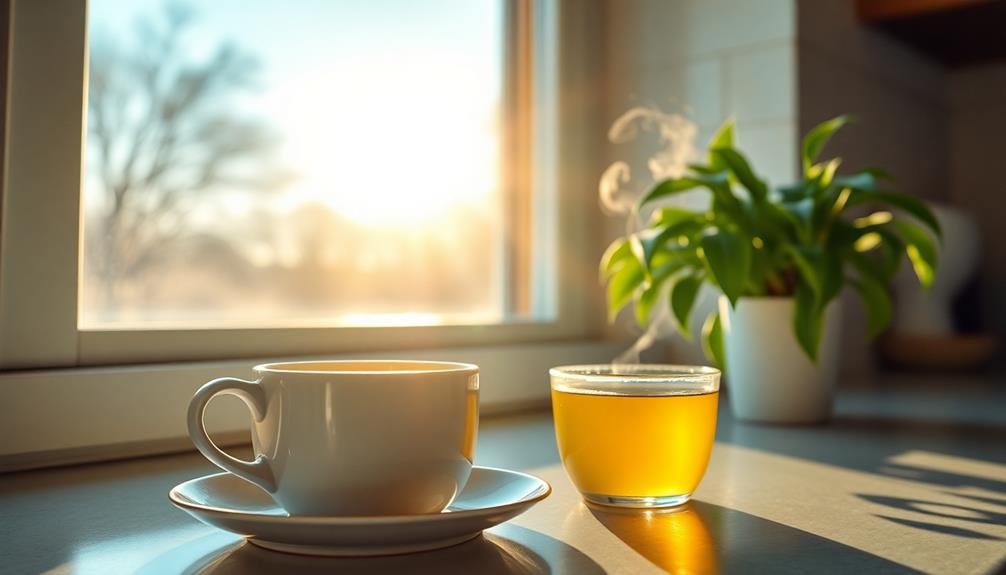
You can kickstart your mornings and ditch coffee with a quick 30-second stretch routine. Start by touching your toes to awaken your muscles, then rotate your hips to boost mobility. Finish with an overhead reach to open up your chest. These simple stretches enhance blood flow and activate your body's relaxation response. Doing this each morning helps you feel more energized and focused without relying on caffeine. Plus, it can improve your posture and reduce back strain. If you're curious about more tips to supercharge your mornings, there's definitely more to explore.
Key Takeaways
- A 30-second stretch routine enhances morning energy by increasing blood flow and joint mobility.
- Key stretches include touching toes, rotating hips, and reaching overhead for maximum benefit.
- Holding each stretch for 10 seconds activates the parasympathetic nervous system, promoting relaxation.
- Regular stretching can reduce reliance on caffeine and improve overall physical performance.
- Consider the Coffee Loophole drink for a revitalizing morning boost without caffeine dependency.
Morning Struggles

Mornings can be tough; you might find yourself dragging out of bed, battling sleepiness and a foggy mind. You're not alone in feeling sluggish and unproductive during those early hours, especially after a long week.
Sleep deprivation and overwork often leave you reaching for that comforting cup of coffee. But this can lead to dependency, making it harder to shake off that morning fatigue. To improve your mornings, consider adopting a routine that includes top wellness tips for a healthier you.
Mental sharpness doesn't come easily in the morning, and without an energizing activity, it can feel like you're moving through quicksand. You might think that cinnamon sugar sprinkled on your breakfast will help wake you up, but while it's a delightful addition, it won't replace the energy boost you need.
Instead, consider how a simple stretching routine can invigorate you. Regular exercise, even just a few minutes of stretching, can greatly enhance your energy levels. It's a natural way to combat those morning struggles and promotes better overall well-being.
The Stretch Routine
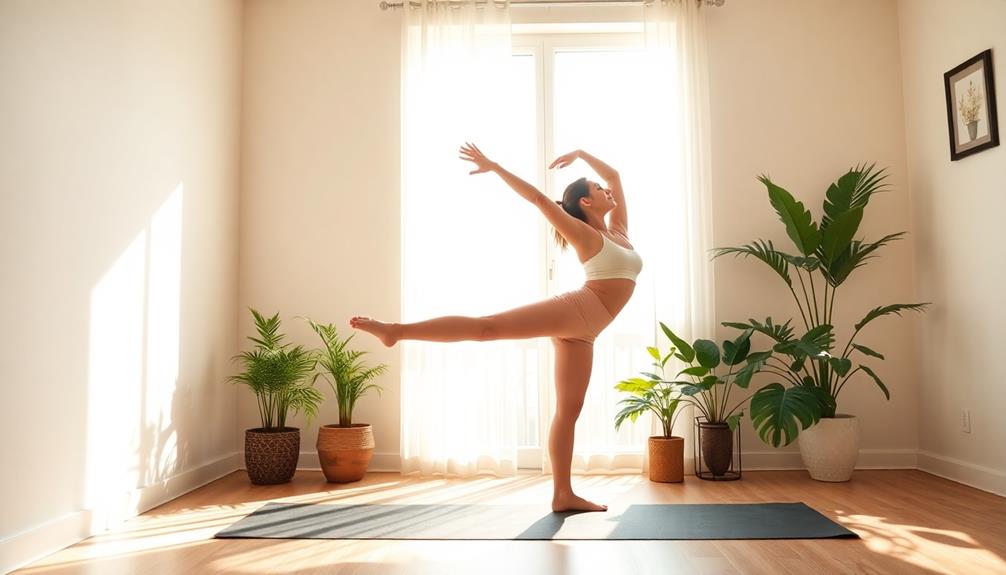
Your morning can transform dramatically with just a few minutes of stretching. The first thing you should do after getting out of bed is dedicate 30 seconds to a simple stretch routine. This consists of three easy steps: touch your toes, rotate your hips, and reach overhead.
Holding each stretch for 10 seconds will activate your parasympathetic nervous system, helping you feel calm and awake without relying on caffeine. Additionally, incorporating essential oils like lavender can enhance relaxation during your morning routine, as aromatherapy can promote relaxation and reduce anxiety symptoms.
Performing this routine right away can easily fit into your busy morning schedule. It activates your parasympathetic nervous system, helping you feel calm and awake without relying on caffeine.
Not only does stretching promote a sense of alertness, but it also increases blood flow and joint mobility. This means you'll reduce muscle tightness and improve your posture throughout the day.
Benefits of Stretching
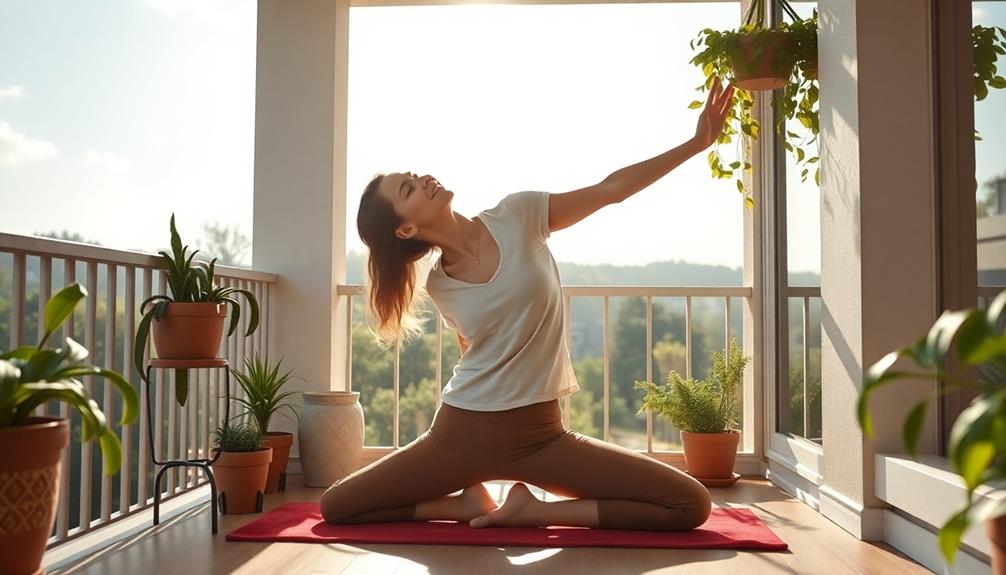
The benefits of stretching extend far beyond mere flexibility; they encompass a holistic approach to physical and mental well-being. When you decided to try incorporating stretching into your morning routine, you're not just improving your flexibility. You're also increasing blood flow and joint mobility, which can enhance your overall physical performance throughout the day.
Additionally, knowing your local gym's operating hours can help you schedule your stretching sessions effectively as part of your overall fitness strategy.
Consistent stretching improves muscle flexibility, leading to reduced back strain and better posture. By engaging in stretching, you activate your parasympathetic nervous system, promoting a sense of calmness and wakefulness without relying on caffeine.
Holding stretches for 5-10 seconds while focusing on your breath aids in relaxation and stress reduction, improving your focus and productivity.
As you continue this practice, you might find it easier to skip that morning cup of coffee, relying instead on your natural energy boosts. Stretching can set a positive tone for your day, enhancing both your body and mind.
By integrating this simple ritual into your mornings, you're not just replacing coffee; you're embracing a healthier lifestyle that fosters well-being and liveliness.
Implementing the Ritual

Kickstarting your day with a simple morning stretch routine can seamlessly replace that cup of coffee you usually crave. Incorporating these stretches aligns with the principles of the Law of Attraction in Sports and Fitness, as it focuses on maintaining high vibrational energy to enhance your overall well-being.
You can learn exactly how to implement this 30-second ritual into your busy schedule with ease. Start by touching your toes for 10 seconds, which helps release tension in your back and legs. Next, rotate your hips for another 10 seconds; this movement enhances flexibility and prepares your body for the day ahead. Finally, reach overhead for 10 seconds to open up your chest and uplift your spirit.
This quick routine requires minimal time and effort, making it perfect for anyone who feels rushed in the morning. By incorporating these stretches, you'll not only boost your energy levels but also promote calmness and reduce stress through activation of your parasympathetic nervous system.
As you practice daily, you'll notice improved posture and reduced back strain, further enhancing your overall well-being. Diminishing your reliance on caffeine becomes effortless when you embrace this natural energy boost.
Coffee Alternative Recipe

If you're looking for a delicious and energizing alternative to your morning coffee, the Coffee Loophole recipe might just be what you need. This unique blend combines black coffee with fresh lemon juice, honey, and a sprinkle of cinnamon, creating a flavorful morning beverage that surprises your taste buds.
To prepare it, simply stir together one tablespoon of lemon juice, one tablespoon of honey, and a sprinkle of cinnamon into your cup of black coffee. Then, grab a milk frother and blend for about 30 seconds until everything's well-mixed.
You'll notice the bright flavor of lemon and the sweetness of honey at first, followed by the rich essence of coffee and the warm notes of cinnamon.
Not only does this drink taste great, but it also packs health benefits. Cinnamon can boost your metabolism, while lemon juice supports weight loss.
Plus, by skipping cream and refined sugars, you're making a health-conscious choice without sacrificing flavor. Give the Coffee Loophole a try, and enjoy an invigorating start to your day!
Frequently Asked Questions
What Is the Morning Ritual for Losing Weight?
To lose weight, start your morning with a quick stretching routine. It boosts blood flow, improves flexibility, and enhances metabolism. You'll feel more energized, focused, and ready to make healthier choices throughout your day.
What Is the Simple Morning Ritual Drink?
Think of this drink as your morning sunrise. You mix black coffee, fresh lemon juice, honey, and cinnamon, creating a flavorful blend that boosts energy and metabolism, all while supporting your health-conscious lifestyle. Enjoy every sip!
What Is the Morning Coffee Ritual?
Your morning coffee ritual involves brewing a fresh cup, savoring the rich aroma, and enjoying the warmth. It energizes you, sharpens your focus, and often becomes a cherished moment shared with others in your life.
What Is the 7 Second Morning Ritual?
You might think you don't have time for a morning ritual, but the 7 Second Morning Ritual is quick and effective. Stretch, rotate, and reach to boost your energy and flexibility, kickstarting your day right.
Conclusion
By embracing this quick morning stretch routine, you're not just swapping out coffee; you're igniting your day like the sun rising over a sleepy horizon. With each movement, you awaken your body and mind, paving the way for clarity and energy that rivals that first sip of caffeine. So, as you roll out your mat and breathe deeply, remember: you're crafting a vibrant morning ritual that fuels you naturally, transforming your daily grind into a dance of liveliness.
In the vast and diverse world of coffee, coffee alternatives, and tea, Olivia has found her calling. As an author and a dedicated coffee and tea aficionado, her work for Cappuccino Oracle reflects her profound love and understanding of the intricate complexities found within these beverages. Olivia’s passion for the subject serves as both a catalyst for her creativity and a connection point with her audience.
Olivia’s appreciation for coffee, coffee alternatives, and tea blossomed at an early age. She discovered that these beverages invigorated her senses and stimulated her creative spirit. From the nuanced flavors of single-origin roasts to the captivating narratives intertwined with coffee, coffee alternatives, and tea trade and culture, Olivia found an unlimited source of inspiration in her daily cup.
Her love for these beverages and her talent for storytelling eventually converged at Cappuccino Oracle. As an author, Olivia’s mission is to illuminate the intricate tapestry that makes up the world of coffee, coffee alternatives, and tea. Her articles span a diverse range of topics, encompassing everything from the unique flavors of different brews to the sociocultural history intertwined with their cultivation and consumption.
Coffee Alternatives And Tea
Coffee Lovers Are Abandoning Starbucks for This Bizarre Alternative
Bizarre alternatives to Starbucks are captivating coffee lovers; discover the unique brews that promise wellness and flavor in every cup.
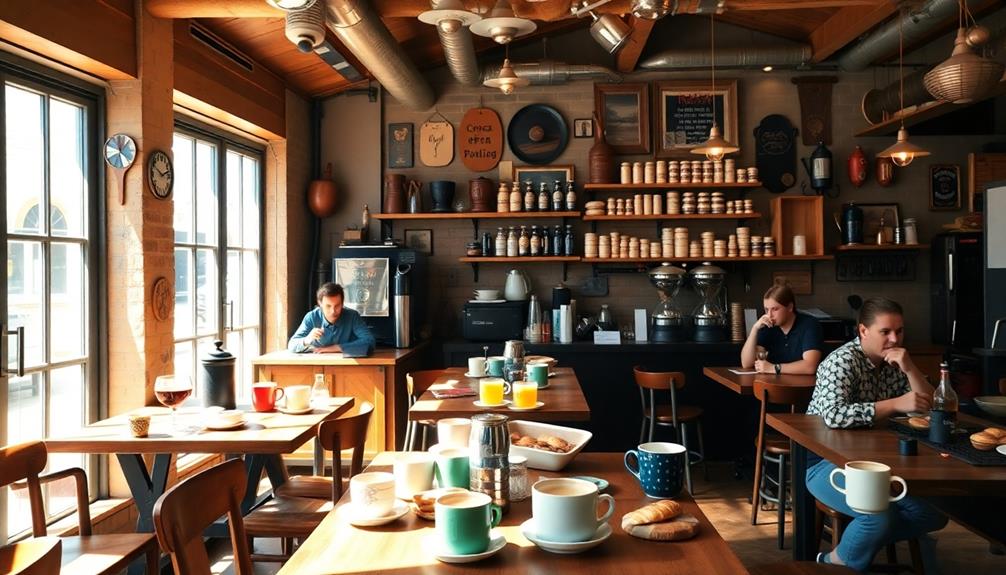
Coffee lovers are ditching Starbucks for more unique and health-focused alternatives. You might notice a rise in local coffee shops that prioritize organic beans and innovative brewing methods. Mushroom coffee and adaptogenic lattes are gaining traction among those seeking wellness benefits. As prices at Starbucks soar, many are turning to affordable, community-driven cafés that offer artisanal drinks with seasonal flavors. This shift reflects a desire for transparency and quality over the corporate experience. Curious about what these alternatives can offer you? Stick around to explore the fascinating world of coffee choices transforming your daily ritual.
Key Takeaways
- Coffee lovers are turning to local shops for unique, artisanal beverages like mushroom coffee and adaptogenic lattes, moving away from mainstream options.
- Rising health consciousness drives consumers to seek organic coffee alternatives, reducing exposure to harmful pesticides and prioritizing clean ingredients.
- Significant price increases at Starbucks have led to dissatisfaction, prompting consumers to explore more affordable and value-driven local coffee shops.
- Social media platforms, particularly TikTok, are fueling interest in diverse flavor profiles and healthier coffee choices, spotlighting independent brands.
- The community-focused atmosphere of local coffee shops fosters connections and supports ethical sourcing, aligning with consumers' values for sustainability.
The Rise of Unique Alternatives

In recent years, you've likely noticed a growing trend: coffee lovers are increasingly abandoning Starbucks for unique alternatives. Many are flocking to local coffee shops that emphasize artisanal brewing methods and transparency in sourcing.
These shops often offer specialty beverages that go beyond the standard cup of joe, introducing options like mushroom coffee and adaptogenic lattes. Health-conscious individuals are drawn to these innovative drinks, seeking caffeine alternatives with potential wellness benefits, such as the calming effects of flower teas.
Social media, particularly TikTok, has amplified this trend, with influencers showcasing bizarre yet intriguing drinks that challenge traditional coffee norms. You might find yourself curious about herbal teas or natural energy drinks as consumers shift toward non-caffeinated options, embracing diverse flavor profiles and healthier choices.
Moreover, many coffee lovers prioritize ethically sourced options, which local shops often provide, contrasting with concerns about corporate practices at larger chains.
This movement not only reflects a desire for unique flavors but also aligns with a growing awareness of sustainability and ethical consumption. As you explore these alternatives, you'll likely discover a richer coffee culture that values quality and creativity over familiarity.
Health Considerations in Coffee Choices
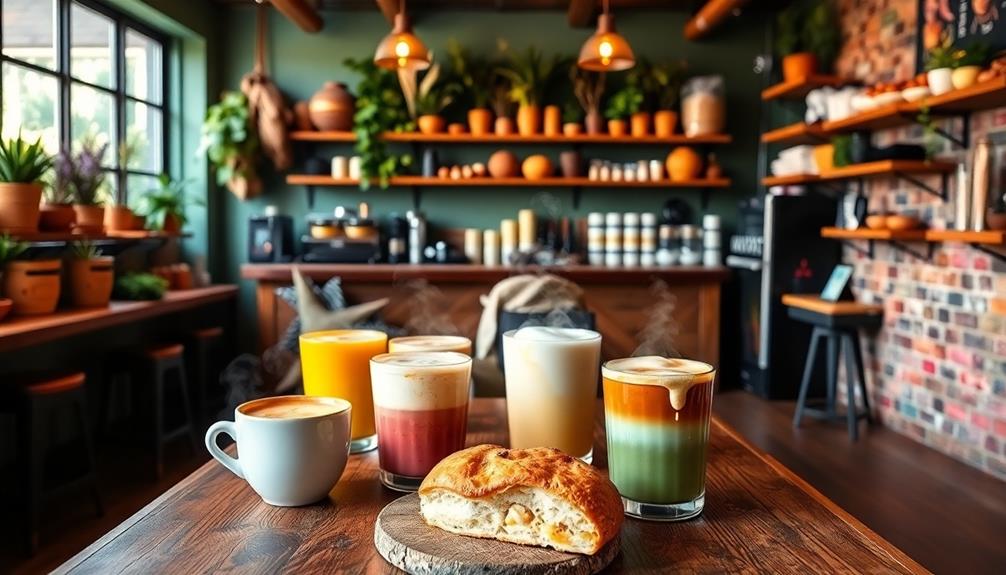
As coffee lovers reevaluate their choices, health considerations are becoming a top priority. You're likely noticing that many consumers are seeking organic coffee options at local shops, prioritizing clean ingredients and transparency in sourcing.
This shift is partly due to health trends highlighting the risks associated with excessive sugar content in popular drinks like the Pumpkin Spice Latte, which blends espresso with seasonal flavors. These sugary beverages can lead to weight gain and increase your risk of diabetes.
Moreover, if you've been frequenting Starbucks, you might be experiencing the downsides of caffeine overconsumption, such as anxiety and insomnia. This awareness prompts many to explore alternatives, including coffee subscriptions that deliver organic coffee right to your door.
By choosing organic options, you can minimize exposure to harmful pesticides and mold often found in commercial coffee brands. Additionally, caffeine content in espresso is an important consideration, as it can vary and affect your overall intake.
Furthermore, the focus on lower-calorie and sugar-free choices reflects a broader movement toward mindful consumption. You may find that homemade coffee recipes or herbal teas are healthier substitutes that align with your wellness goals.
Ultimately, prioritizing health in your coffee choices can lead to a more satisfying and beneficial experience.
Customer Sentiment Towards Starbucks
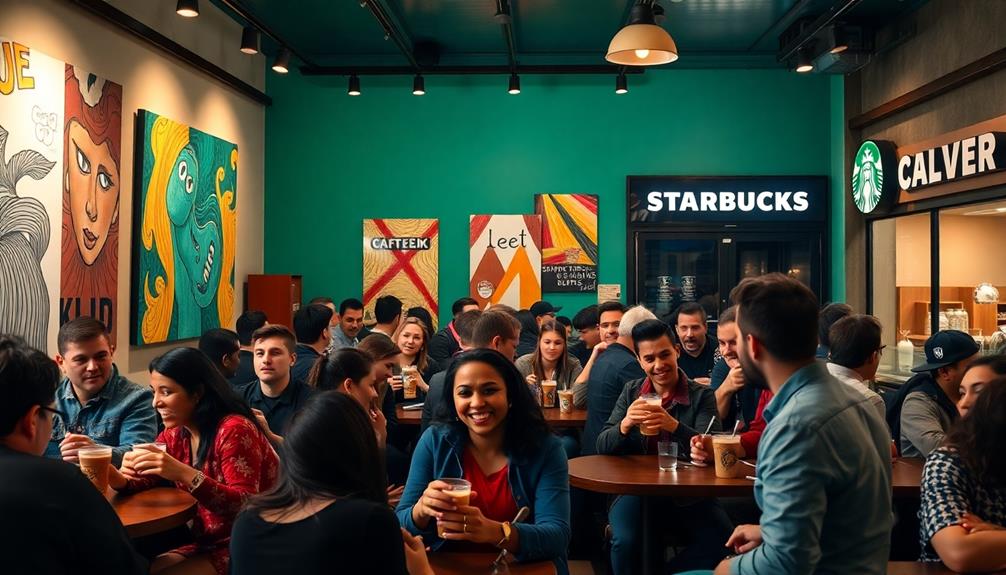
Dissatisfaction with Starbucks is on the rise, as many customers are fed up with soaring prices and a perceived decline in value. With average menu prices increasing by 25%, it's no wonder you're seeking more affordable alternatives.
The recent 6% drop in transactions at North American stores suggests you're not alone in this sentiment; more people are resisting the urge to indulge at Starbucks. Additionally, many coffee lovers are becoming increasingly aware of the health benefits associated with high-quality coffee, such as its antioxidant properties and potential mood enhancement, leading them to seek out better options fresh insights on coffee benefits.
Social media discussions, especially on TikTok, have highlighted the emotional and financial toll of regular Starbucks visits. Many are sharing their struggles with coffee addiction, prompting a shift toward local coffee shops that offer more transparency and better value.
Concerns about ingredient quality, such as potential mold and pesticides in Starbucks' coffee beans, have further fueled this trend.
You're not just looking for a caffeine fix anymore; you want to support businesses that prioritize organic and ethically sourced options. Community sentiment is clearly leaning towards local coffee shops, where you can enjoy a cup of coffee that aligns with healthier lifestyle choices.
This shift in customer sentiment reflects a growing desire for authenticity and connection in your coffee experience.
Exploring Local Coffee Culture

A vibrant local coffee culture is capturing the hearts of many, offering a revitalizing alternative to the corporate giants like Starbucks. You'll find that local coffee shops prioritize quality and sustainability, often sourcing organic and ethically produced beans. This focus attracts health-conscious consumers who crave unique flavors and personalized experiences that larger chains often lack.
Many local cafes also enhance their offerings with healthy coffee additives, such as cinnamon and MCT oil, appealing to those seeking both taste and wellness.
When you visit a local coffee shop, you'll discover creative and seasonal beverages that reflect regional tastes, providing authenticity in your coffee choices. These establishments often host community-driven initiatives, like coffee tastings and workshops, creating opportunities for you to connect with local roasters and fellow coffee lovers.
Supporting these independent shops isn't just about enjoying great coffee; it's also a way to invest in your community's economy. Many consumers are driven by concerns over corporate ethics, choosing to back businesses that align with their values.
Future Trends in Coffee Consumption

With a shift in consumer preferences, the future of coffee consumption is poised for transformation. You're likely to see exciting changes that reflect a growing desire for quality and wellness. As more people become aware of the health benefits of coffee, the demand for organic options is likely to rise.
Here are four key trends shaping this future:
- Local Coffee Shops: More coffee lovers are turning to local cafés, seeking organic options and a personal touch that major chains like Starbucks can't offer.
- Health-Conscious Choices: Caffeine-free alternatives and herbal teas are gaining traction as people prioritize wellness over traditional coffee drinks.
- Social Media Influence: Platforms like TikTok are driving younger consumers to explore unique, artisanal coffee experiences, steering them away from the familiar Starbucks menu.
- DIY Coffee Culture: The rise of homemade coffee recipes allows you to enjoy your favorite drinks while controlling the quality and nutritional content, catering to the demand for transparency.
As these trends continue to evolve, you can expect the coffee landscape to become increasingly diverse, with a focus on sustainability, health, and creativity.
Embrace these changes and discover a world of coffee that aligns more closely with your values and tastes.
Frequently Asked Questions
What Are the Substitutes for Starbucks Coffee?
You've got plenty of substitutes for Starbucks coffee. Try local coffee shops for unique flavors, whip up homemade recipes, or explore herbal teas and natural energy drinks like yerba mate and matcha for a revitalizing change.
Why Were People Mad at Starbucks?
You scroll through social media, seeing friends vent about Starbucks' steep price hikes and long wait times. They've shifted from cozy gatherings to rushed transactions, leaving you questioning if it's worth the trip anymore.
What Does Starbucks Do Other Than Coffee?
Starbucks isn't just about coffee; you can enjoy a variety of teas, fresh lemonades, and unique seasonal drinks. Plus, they offer delicious pastries, sandwiches, and customizable beverages to suit your taste preferences perfectly.
What Do I Do if I Don't Like My Starbucks Order?
If you don't like your Starbucks order, just let the barista know right away. You can request adjustments, ask for a remake, or customize your drink to better suit your preferences. Enjoy your coffee!
Conclusion
As the aroma of freshly brewed alternatives fills the air, you can sense a shift in the coffee landscape. You're not just sipping a drink; you're savoring an experience that resonates with your taste and values. The vibrant local cafés, where baristas craft unique blends, invite you to explore uncharted flavors. With each cup, you're part of a movement, leaving behind the familiar comforts of Starbucks for a bold, personalized journey that awakens your senses and ignites your passion for coffee.
In the vast and diverse world of coffee, coffee alternatives, and tea, Olivia has found her calling. As an author and a dedicated coffee and tea aficionado, her work for Cappuccino Oracle reflects her profound love and understanding of the intricate complexities found within these beverages. Olivia’s passion for the subject serves as both a catalyst for her creativity and a connection point with her audience.
Olivia’s appreciation for coffee, coffee alternatives, and tea blossomed at an early age. She discovered that these beverages invigorated her senses and stimulated her creative spirit. From the nuanced flavors of single-origin roasts to the captivating narratives intertwined with coffee, coffee alternatives, and tea trade and culture, Olivia found an unlimited source of inspiration in her daily cup.
Her love for these beverages and her talent for storytelling eventually converged at Cappuccino Oracle. As an author, Olivia’s mission is to illuminate the intricate tapestry that makes up the world of coffee, coffee alternatives, and tea. Her articles span a diverse range of topics, encompassing everything from the unique flavors of different brews to the sociocultural history intertwined with their cultivation and consumption.
-

 Coffee Basics3 weeks ago
Coffee Basics3 weeks ago10 Potential Health Risks of Single-Serve Coffee Pods and How to Mitigate Them
-

 Coffee Basics3 weeks ago
Coffee Basics3 weeks agoCaffeine Content Comparison: Nespresso Vs. Traditional Coffee Vs. Energy Drinks
-

 Coffee Basics2 weeks ago
Coffee Basics2 weeks agoYerba Mate: The South American Superfood and Its Health Benefits
-

 Coffee Basics2 weeks ago
Coffee Basics2 weeks agoThe Impact of Coffee on Digestive Health: What Science Says
-

 Coffee Basics3 weeks ago
Coffee Basics3 weeks agoCelebrity Coffee Habits: Insights From TV and Movie Stars
-

 Coffee Basics3 weeks ago
Coffee Basics3 weeks agoSoft Drinks and Medical Tests: What You Need to Know
-

 Coffee Basics2 weeks ago
Coffee Basics2 weeks agoHerbal Teas for Every Occasion: From Relaxation to Romance
-

 Coffee Basics3 weeks ago
Coffee Basics3 weeks agoMaximizing the Shelf Life of Your Matcha: Storage Tips and Tricks































